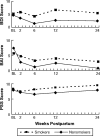The association of depressive, anxiety, and stress symptoms and postpartum relapse to smoking: a longitudinal study
- PMID: 19436040
- PMCID: PMC2722237
- DOI: 10.1093/ntr/ntp053
The association of depressive, anxiety, and stress symptoms and postpartum relapse to smoking: a longitudinal study
Abstract
Introduction: The aim of this prospective repeated measures, mixed-methods observational study was to assess whether depressive, anxiety, and stress symptoms are associated with postpartum relapse to smoking.
Methods: A total of 65 women who smoked prior to pregnancy and had not smoked during the last month of pregnancy were recruited at delivery and followed for 24 weeks. Surveys administered at baseline and at 2, 6, 12, and 24 weeks postpartum assessed smoking status and symptoms of depression (Beck Depression Inventory [BDI]), anxiety (Beck Anxiety Inventory [BAI]), and stress (Perceived Stress Scale [PSS]). In-depth interviews were conducted with women who reported smoking.
Results: Although 92% of the participants reported a strong desire to stay quit, 47% resumed smoking by 24 weeks postpartum. Baseline factors associated with smoking at 24 weeks were having had a prior delivery, not being happy about the pregnancy, undergoing counseling for depression or anxiety during pregnancy, and ever having struggled with depression (p < .05). In a repeated measures regression model, the slope of BDI scores from baseline to the 12-week follow-up differed between nonsmokers and smokers (-0.12 vs. +0.11 units/week, p = .03). The slope of PSS scores also differed between nonsmokers and smokers (-0.05 vs. +0.08 units/week, p = .04). In qualitative interviews, most women who relapsed attributed their relapse and continued smoking to negative emotions.
Discussion: Among women who quit smoking during pregnancy, a worsening of depressive and stress symptoms over 12 weeks postpartum was associated with an increased risk of smoking by 24 weeks.
Figures
References
-
- American College of Obstetricians and Gynecologists. A clinicians guide to helping pregnant women quit smoking. 2002. Retrieved April 16, 2009, from http://acog.org/from_home/departments/smoking/smokingLectureGuide.pdf.
-
- Beck AT, Epstein N, Brown G, Steer RA. An inventory for measuring clinical anxiety: Psychometric properties. Journal of Consulting and Clinical Psychology. 1988;56:893–897. - PubMed
-
- Beck AT, Ward CH, Mendelson M, Mock J, Erbaugh J. An inventory for measuring depression. Archives of General Psychiatry. 1961;4:561–571. - PubMed
-
- Blalock JA, Robinson JD, Wetter DW, Cinciripini PM. Relationship of DSM-IV-based depressive disorders to smoking cessation and smoking reduction in pregnant smokers. American Journal of Addiction. 2006;15:268–277. - PubMed
-
- Breslau N, Kilbey M, Andreski P. Nicotine dependence, major depression, and anxiety in young adults. Archives of General Psychiatry. 1991;48:1069–1074. - PubMed


